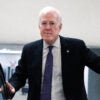When a family want to spend more money on a house, a car, education, or anything else they want to buy, the first question they ask themselves is “Where will the money come from?” When Congress asks the Congressional Budget Office (CBO) to score how spending increases will affect the economy, the CBO does not ask this basic question, even though the magnitude of government spending is astronomically higher. This short-sighted approach makes government spending look more advantageous than it really is.
Updating Dynamic Scoring Model
Under the new budget rules Congress passed earlier this year, the CBO is required to dynamically score spending bills that have a substantial impact on the economy. Dynamic scoring accounts for the macroeconomic effects of changes in fiscal policy, whereas traditional static scoring does not.
The Daily Signal depends on the support of readers like you. Donate now
The CBO should dynamically score spending bills, but it needs to update its model to do so more accurately. Specifically, it needs to account for the fact that the government must first take money out of the economy before it can spend the money. It does so either through taxation or by borrowing from the same credit markets that families use when they want to buy a new car or home or to invest in education and that businesses use when they want to invest to increase capacity.
Right now, the CBO does not account for the fact that the government takes money out of the economy when it spends. Thus, its analyses create a bias in favor of government spending.
Breaking the Spending Caps
For instance, at the request of Senator Bernie Sanders (I-Vt.), the CBO recently dynamically scored the effects on the economy if Congress increased spending by breaking the spending caps established by the Budget Control Act of 2011. In its analysis, the CBO found:
Over the course of calendar year 2016, on average, CBO estimates that the spending changes would make real (inflation-adjusted) gross domestic product (GDP) 0.4 percent larger than projected under current law. They would also increase full-time-equivalent employment by 0.5 million. … [T]he increase in federal spending would lead to more aggregate demand than under current law.
Over the course of calendar year 2017, on average, CBO estimates that the spending changes would make real GDP 0.2 percent larger than projected under current law. They would also increase full-time-equivalent employment by 0.3 million.
The CBO analysis estimates a slight improvement in the economy from the increased spending because it does not consider that the government must borrow the money before spending it. (Since the federal government is running a massive deficit right now, it is assumed the extra spending is financed through borrowing.) The CBO acknowledges that increased debt would hurt the economy in the long run.
A Keynesian Fallacy
Failing to account for the fact that the government must take money out of the economy before spending it is a central fallacy of Keynesianism, which was discredited yet again by the 2009 stimulus that failed to stimulate the economy. Keynesianism assumes that government spending comes with no cost, and the CBO analysis mimics that mistake.
If the CBO rightfully took into account that the government would take the extra spending money from private credit markets—which would thus no longer be available for the private market to borrow—the small economic improvement found by the CBO would evaporate.
This would occur because the analysis would correctly take into account that the private sector would have spent the money if the government had not taken it and, at the very least, would have spent it in a way that produced similar economic benefits as government spending. In reality, the private sector would probably spend the money more efficiently. Right now, the CBO effectively assumes that the same dollar is spent twice, which is impossible.
The Transportation Bill
The CBO needs to improve its scoring model soon because Congress may ask it to dynamically score a transportation bill, which would also substantially increase spending, as busting the spending caps would. If the CBO maintains its current practices, it will likely show that transportation spending is much more economically beneficial than it truly is.
To avoid this error, all the CBO needs to do is ask, “Where will the money come from?”




























